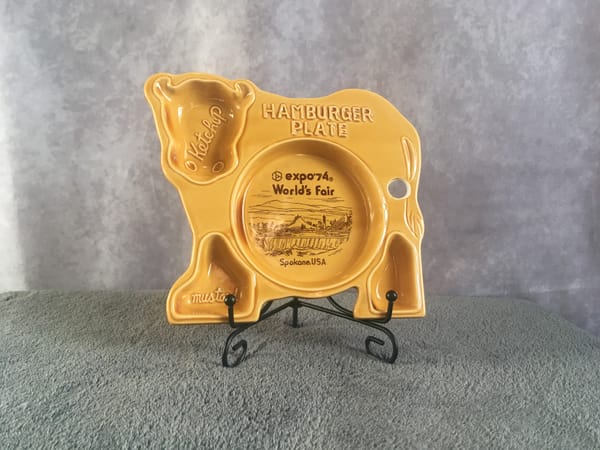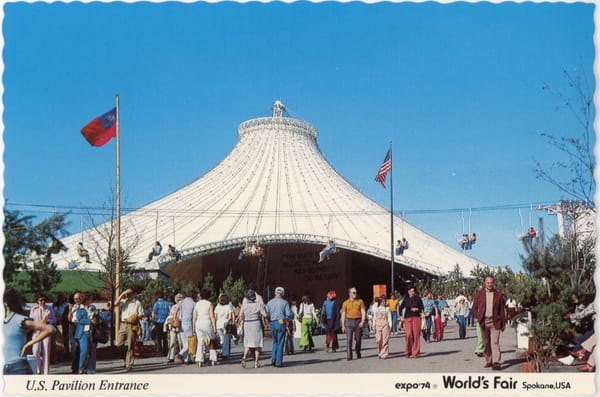June 1-June 7: Native Americans' Earth and Save the Whales

I hope you like Estonian sourdough bread, because it's Baltic Week at the Folklife Festival! Activities also included traditional Latvian amber jewelry-making, Estonian folk dance, decorative carving, and embroidery.(1)
I'll take this week as an opportunity to introduce Folklife's neighbor and/or roommate, "Native Americans' Earth."(2) Although plenty of world's fairs had displayed aspects of Native life over the years (often in a very derogatory way), this was the first time that space at a world's fair had been set aside for Native folks to tell their own story in the present tense. According to the Official Souvenir Program:
You're in Indian Country!
While you tour Expo '74 and the Folklife festival you see one-fourth of the $1.1 million budget allocated for native Americans participation in Expo. Indians of America, especially those of the Northwest, are displaying their art and culture during the Fair. A total of 128 tribes, bands, and Indian affiliated organizations laid plans for the program.
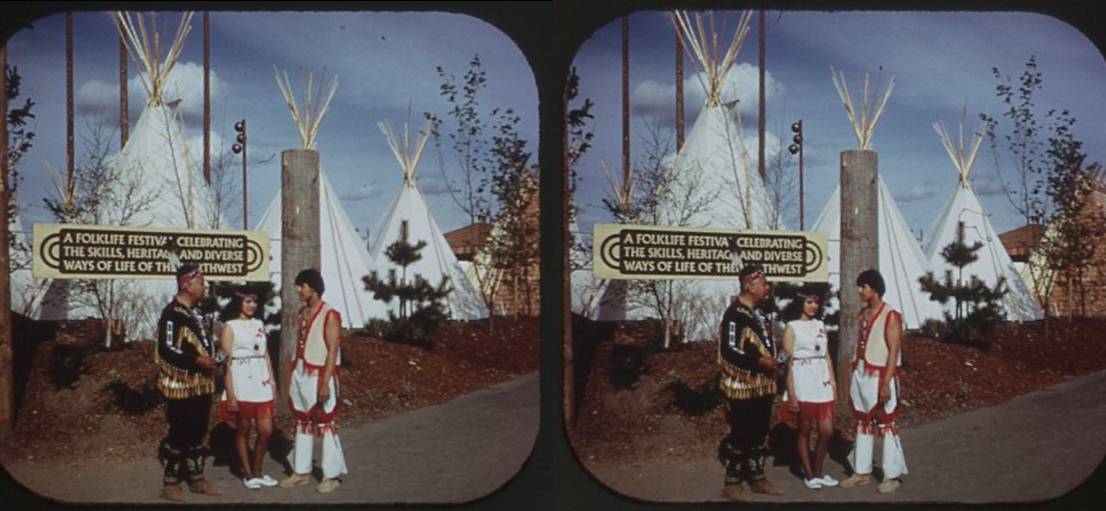
Like Folklife, NAE brought in artisans and performers from different cultures each week. Unfortunately, the newspapers did not cover these changes in the schedule as closely as they did for Folklife, and sometimes just says "Indian crafts and dancing" when NAE is mentioned on the schedule. I'll try to highlight specifics when I find them. This week featured crafts and dancing from the "Yakimas, Grosventres, and Lummis."(4)
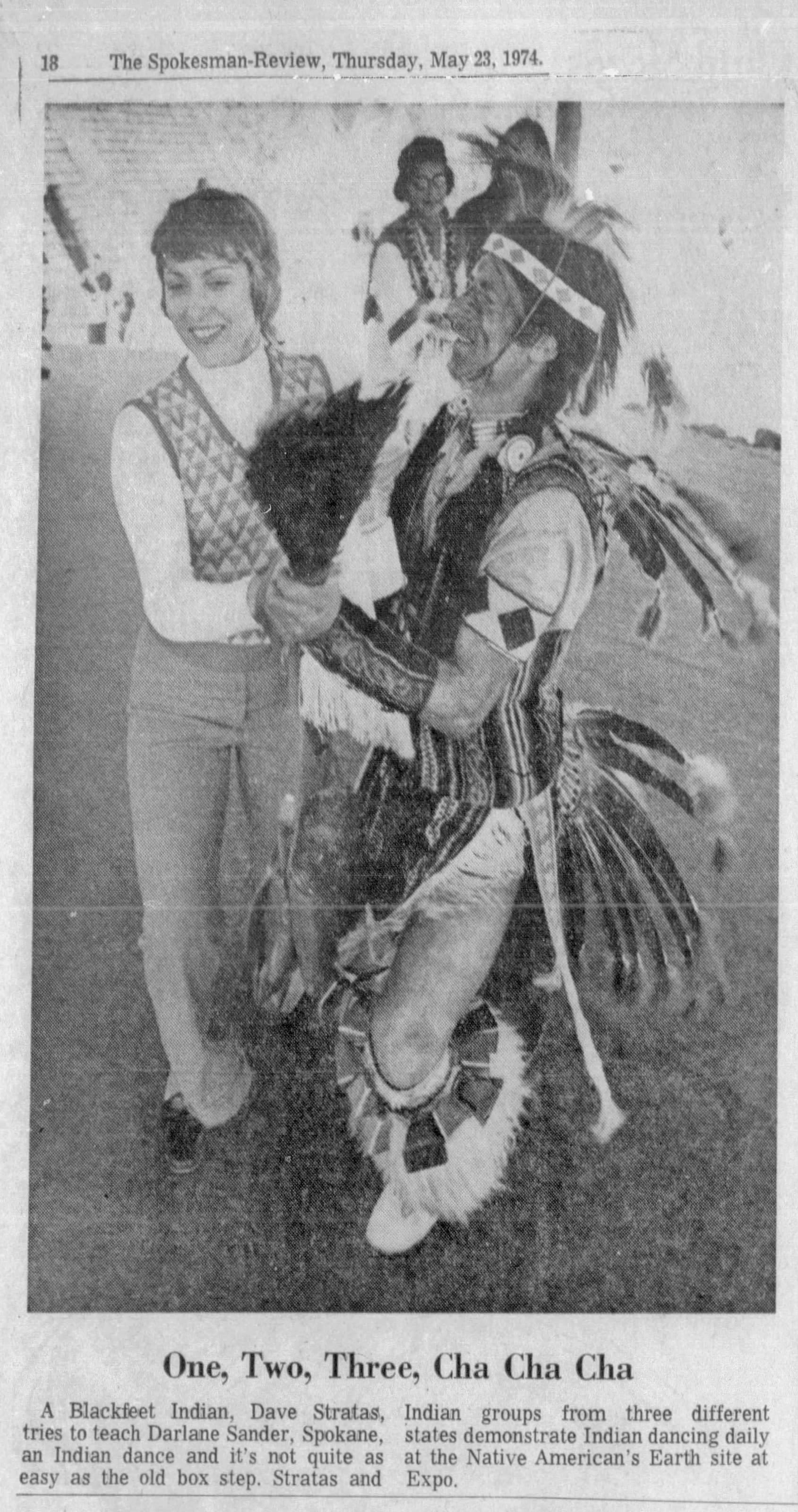
It sounds like it was a very popular experience both for the presenters and the visitors.(5) Today, Echoes of Expo released called "River People" and I'm really looking forward to listening to it and hearing more about that experience from people who were there.
THIS WEEK'S EVENTS
Saturday, June 1, 1974 had festival day ceremonies for Arkansas, Missouri, New Hampshire, New Jersey, and the Soviet Union.(5). The Emmett Kelly, Jr. Circus continued its run at the Opera House.
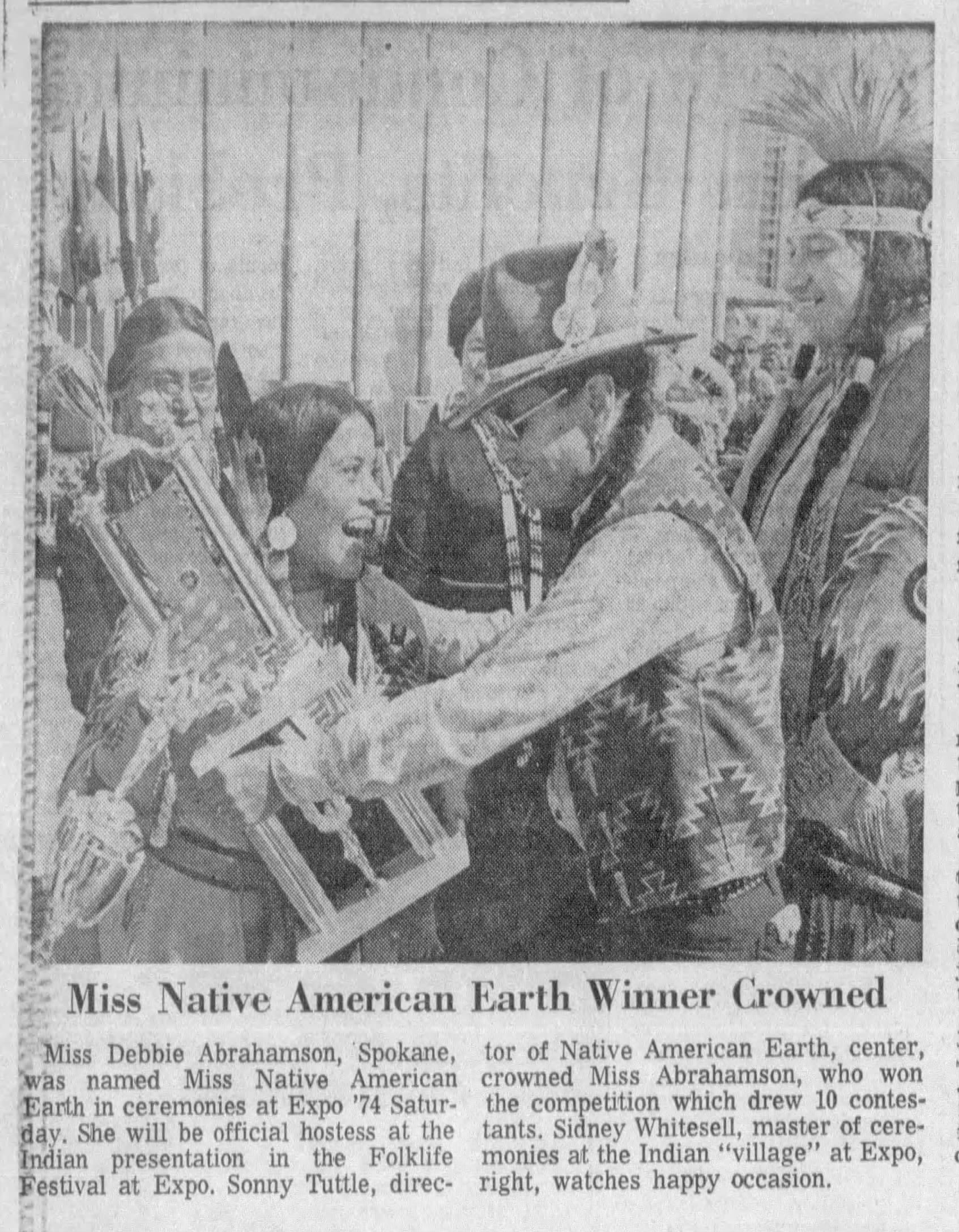
The weekend was marred by some notable thefts, including six of the flags from the poles on Canada Island. That is, these ones:
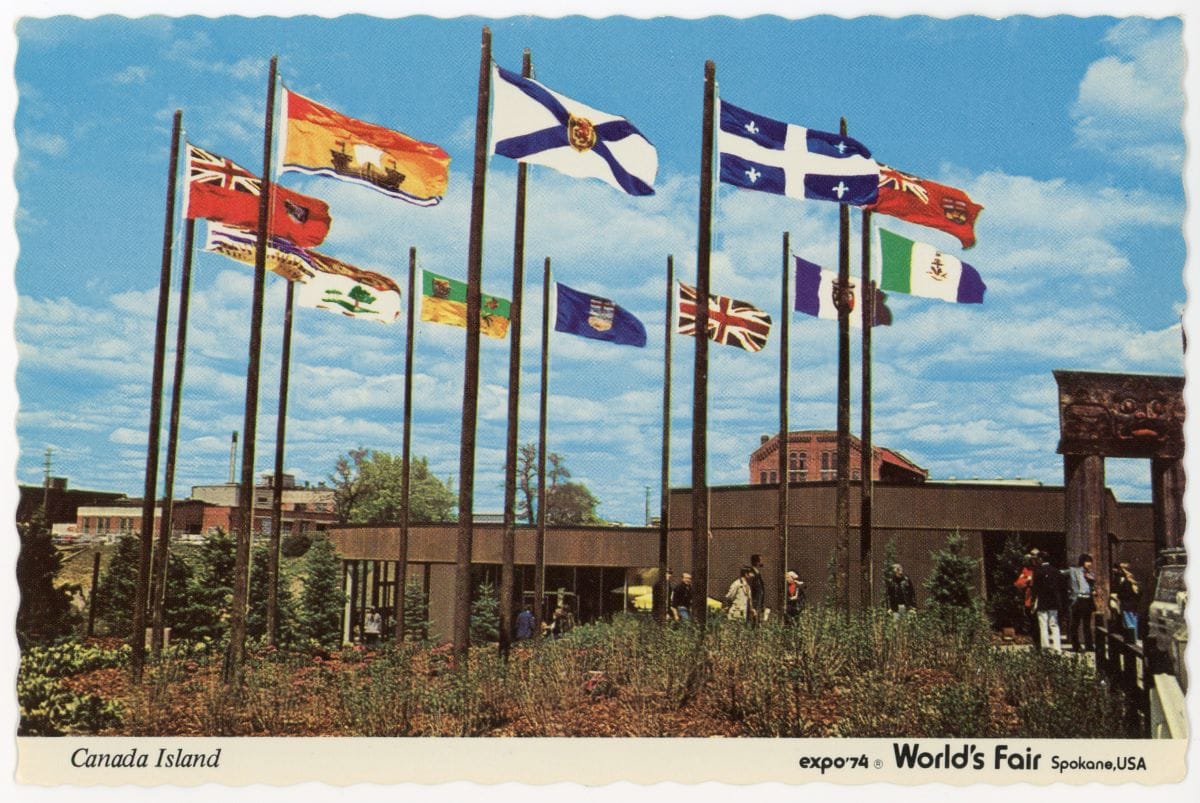
I can't imagine the resale value of those would have been high, so perhaps it was general shenanigans and tomfoolery. An American flag from the Expo site post office also disappeared, as did 24 necklaces stolen from the Philippines Pavilion's product display.(6)

Remember Terry Brauner, the daredevil from Kettle Falls who tried to go down the river and over the falls a couple of weeks back. So did the Spokane City Council, particularly when he started to talk about doing it again. On Monday, June 3, 1974, the Council passed an ordinance against swimming or floating in the river between the eastern tip of Havermale Island and the Monroe Street Bridge.(7) Persons who violated the ordinance could be fined $300, spend 90 days in jail or both.
On Tuesday, June 4, 1974, the Spokesman-Review passed along the word that people in the area were claiming to be conducting surveys about Expo '74, but were in fact thieves who were using the opportunity to case potential targets for home robberies.(8)
Wednesday, June 5, 1974 was Coeur d'Alene festival day and an observance of the United Nations World Environment Day at the Opera House. It was also the day that a group of young people wearing "Save the whales" stickers were banned from entering the fair. Their plan had been to march from the Coliseum, through the fairgrounds, and to the Opera House for the UN World Environment Day observance.(9) While the marchers agreed to leave their placards and signs outside the gates when asked, an Expo official then told them that Expo policy prohibited them wearing stickers or pins inside; an alternate version says that an Expo official told them they could not distribute booklets or pamphlets inside.(10, 11)
The stringent response was likely due to an aggressive "Save The Whales!" piece that had been running in area newspapers that same week, appearing in ad space purchased by the Animal Welfare Institute. The text of this advertisement included the following:
The Japanese and Russians are guilty of blatant hypocrisy in their EXPO '74 exhibitions. They piously claim to be supreme environmentalists, to be lovers of nature. But they are raping Mother Nature, particularly in the oceans where the remaining whale stocks and fisheries are being systematically wiped out by the huge Japanese and Soviet fleets. When you are at EXPO, tell the Japanese and Russians how you feel about their rape of the seas.
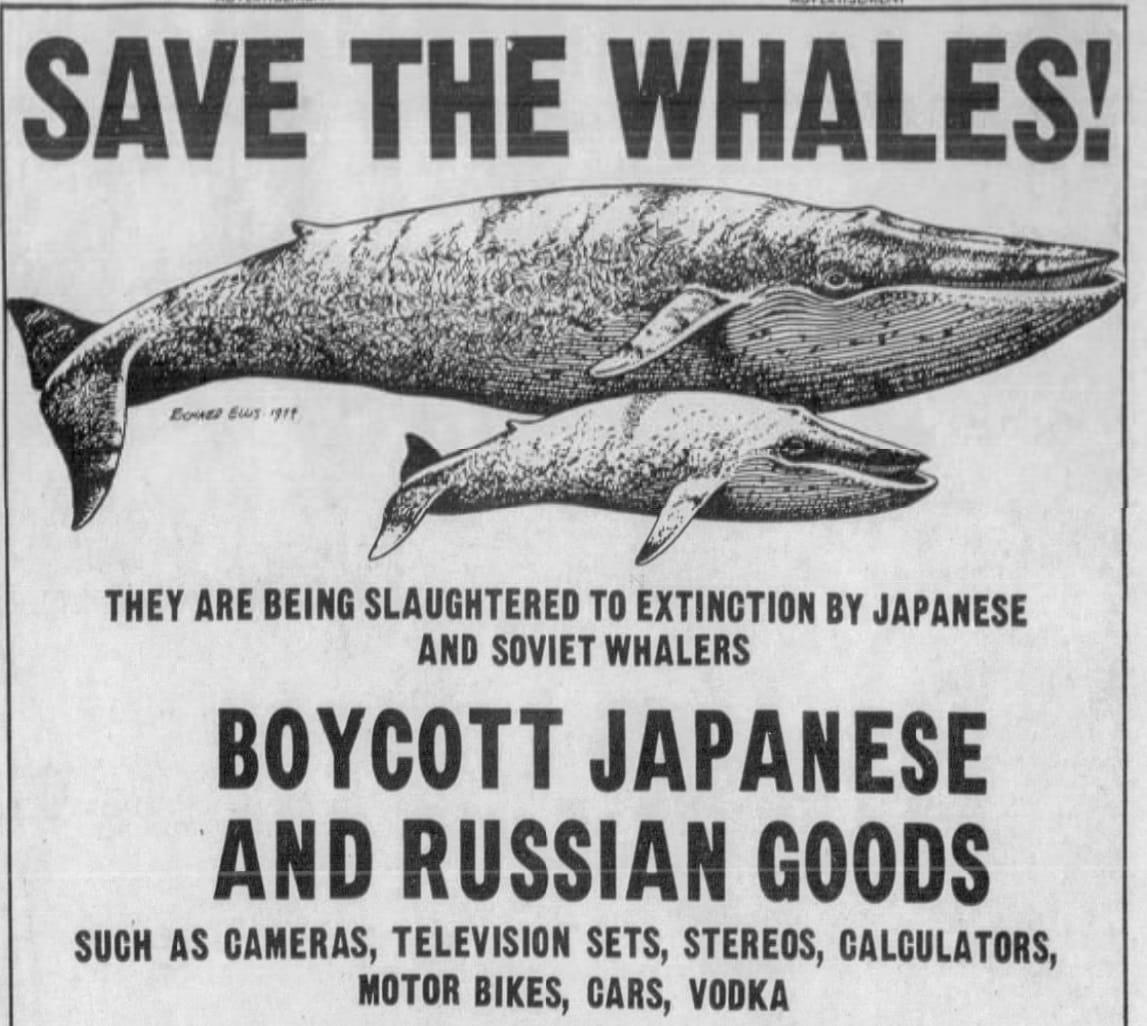
Unsurprisingly, representatives of both the Soviet Pavilion and the Japanese Pavilion objected to this characterization, and Expo administration was probably feeling a bit tense about the topic of whaling that week.(12) Unfortunately, the Animal Welfare Institute's campaign had nothing to do with the Whale Walks, which were organized locally and led by high school students.

Public response to the issue seemed to think that, although nobody wanted Expo to be taken over by protest marches, this was not the hill to die on. They also pointed out the same thing I thought when first encountering this story, which is that "wearing buttons or stickers" and "handing out pamphlets" were activities that were absolutely happening at Expo every single day. It was a pin, sticker, and pamphlet-oriented event and I have the collection to prove it.
On Thursday, June 6, 1974, the Philadelphia Orchestra performed in the Opera House and Lawrence Welk and his "champagne music makers" performed at the Coliseum.(13, 14) I would like to share with you all the funniest and most surreal Lawrence Welk performance that I ever accidentally caught on PBS, a "modern spiritual by Dale and Gail":
On Friday, June 7, 1974 Bill Cosby did two comedy shows at the Opera House.(15)
The "ATTENDANCE" section can be merged into WEEKLY EVENTS this week, because Expo '74 welcomed its millionth visitor on Saturday, June 8th, 1974.(16) His name was Don J. Bonillas, and he and his family were stopping at Expo '74 on their way to Alaska, where Don was about to start a new job. The family was greeted by King Cole and taken to the Expo '74 Executive VIP Club for lunch. Don was given an Expo tie, his wife was given a scarf, and the kids got souvenir pins. (Pins!)
PAVILION/EXHIBIT HIGHLIGHT: AUSTRALIA
Australia provided Expo ‘74 with one of its most popular pavilions. To the relief of fair planners, this success was accomplished with minimal behind-the-scenes drama. Australia’s fair committee confirmed their participation early, pulled together an appealing exhibit for their provided space, and opened on schedule. Over the duration of the fair, more than two million visitors would explore Australia’s pavilion.
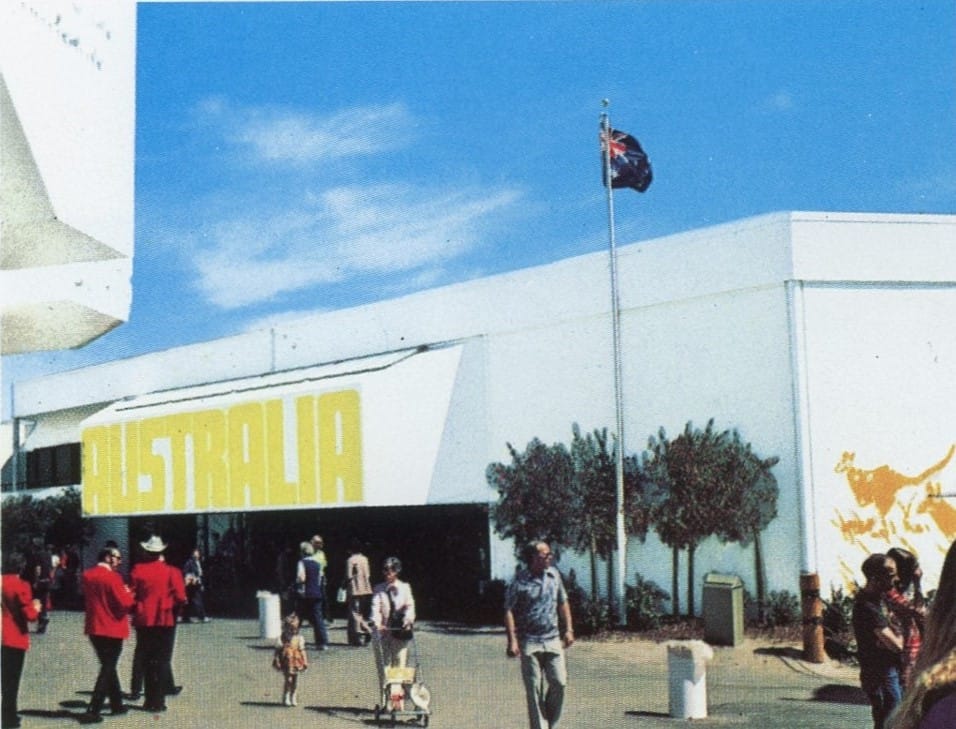
Located on the east side of Havermale Island, the Australia Pavilion occupied a two-story building, with 7500 square feet on the lower level and 5000 on the upper level. There were two escalators in the pavilion - one bringing visitors up to the mezzanine, and one bringing them down again. This arrangement facilitated traffic flow as well as dividing the pavilion into three areas: “The Natural Order,” “Man’s Impact on Nature,” and “The Life Cycle of a Nation.” The interior decor of the pavilion was characterized by “lush Australian wool carpeting on the floor and up the walls.”
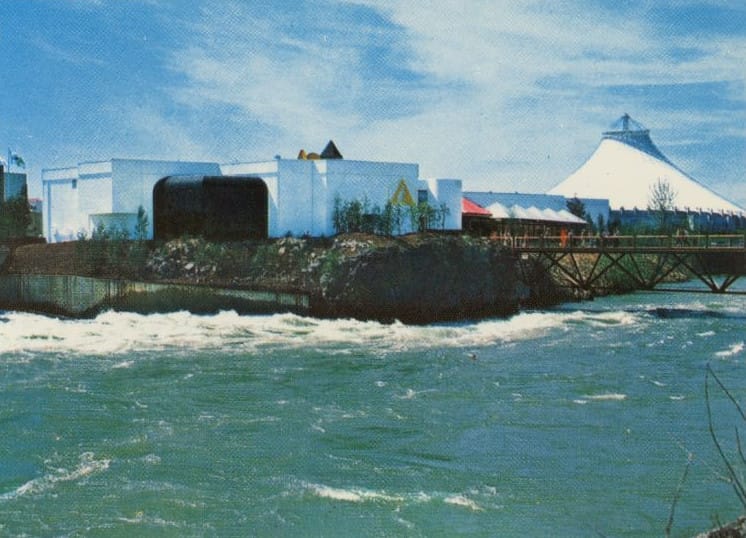
The first section of the pavilion, “The Natural Order,” showed off the beautiful aspects of Australia that were “untouched by man,” including photographs of natural areas in Australia and mounted specimens of Australian animals such as a stuffed kangaroo and stuffed alligator. Other aspects of Australia “untouched by man” featured in this area were the Great Barrier Reef and aboriginal artifacts. (The pavilion brochure made it clearer that this section was intended to show Australia as untouched by European men.)
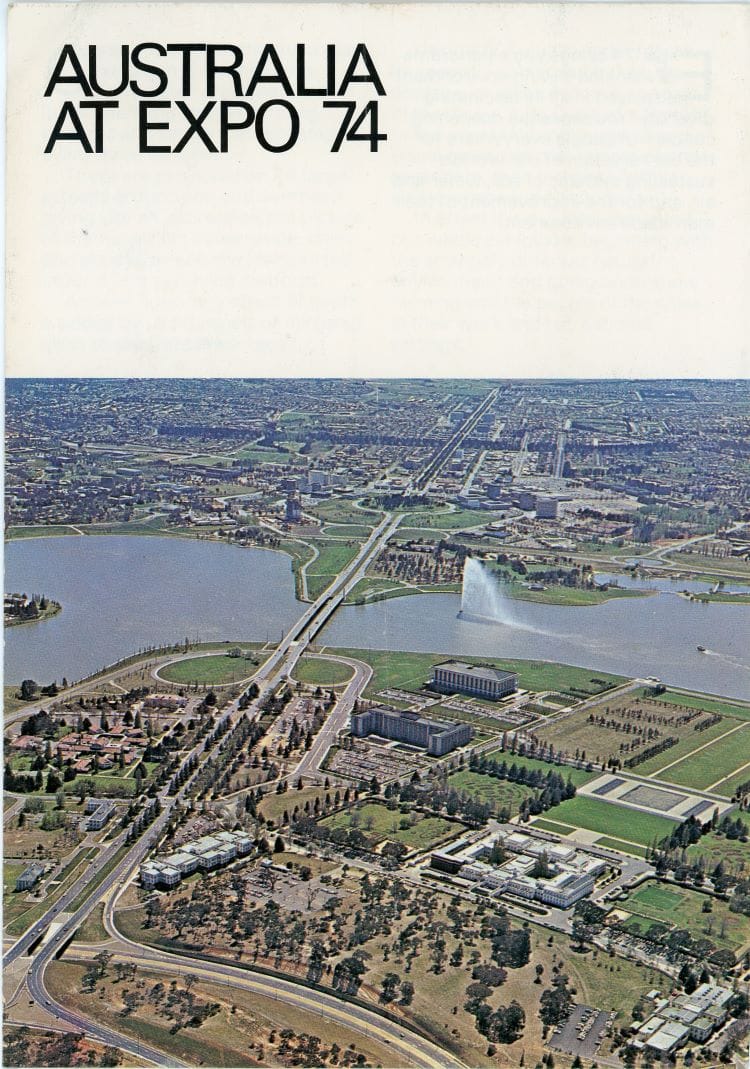
Up the first escalator, the mezzanine showed off a view of the Spokane river and an extensive array of plant life, including eucalyptus. According to pavilion plans, the mezzanine section was additionally subdivided into three sections: “The Australian Ugliness” (large photos of things like “industrial slums, city decay, telegraph, mutilated trees”), “Human Values,” (an exhibit about the average Australian’s home life and the model city of Canberra), and a large model of the Sydney Opera House.

Down the second elevator, the “Life Cycle of a Nation” section was interpreted literally, as visitors would step onto a turntable in the floor and rotate around inside a room full of screens, color slides, and mirrors. The turntable made a full rotation every three minutes. This approach was intended to create “an amazing illusion of an endless horizon for man and his environment.”
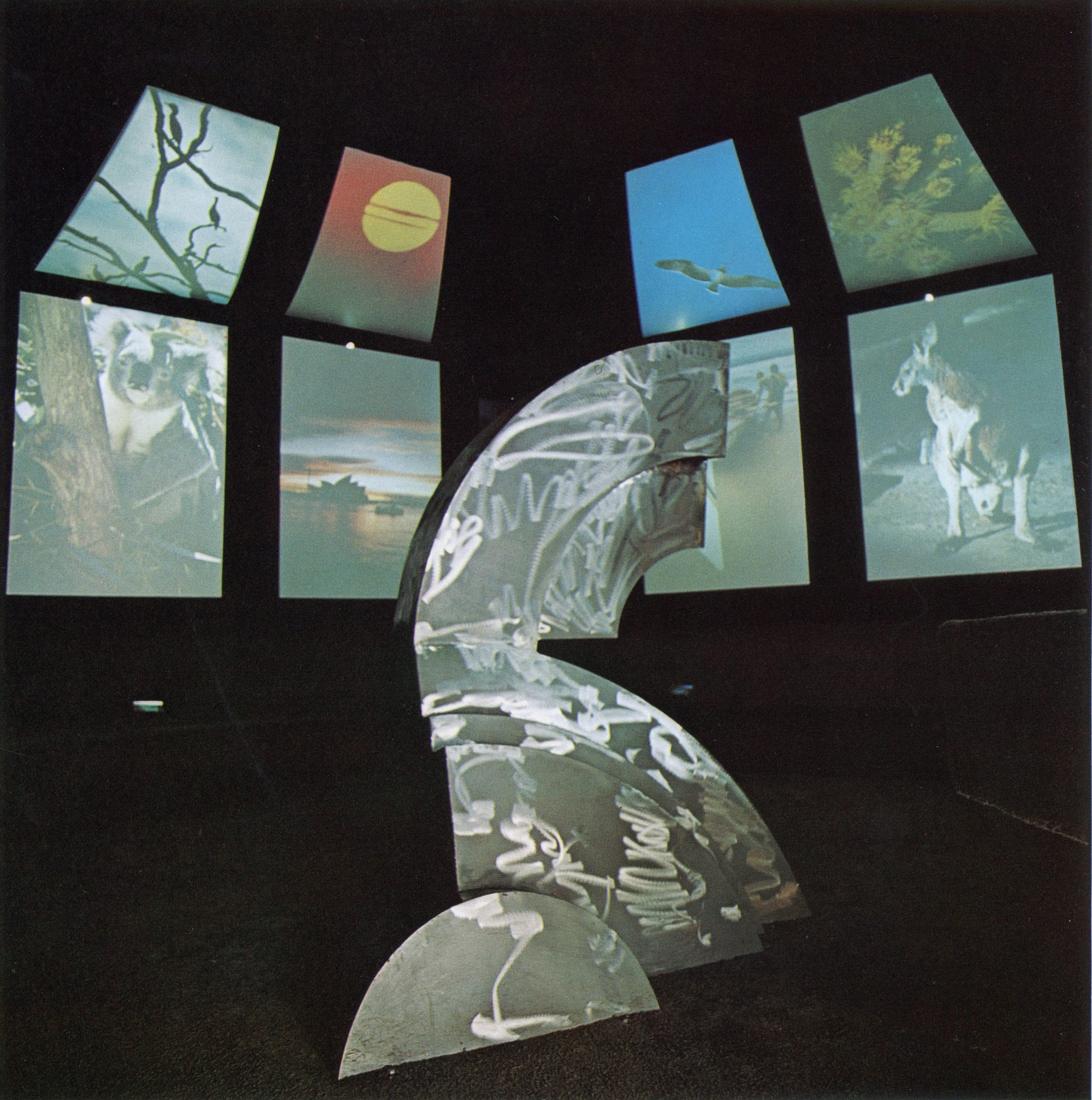
From the Official Souvenir Program:
Australia’s unique flora is featured in the 12,000 sq. ft. Australia Pavilion. What the Australian people are like is demonstrated by a group of young people. Displays show how Australia is handling its environmental problems.
The pavilion includes a private dining room, VIP area and a unique central mirrored hexagon room, with a revolving viewing platform, containing slides and music to convey Australia’s successes.
At least two booklets from the Australia Pavilion focused on encouraging immigration to Australia, rather than attracting tourists. At the time, Australia was in the process of dismantling its “White Australia policy” toward immigration, and had only banned race as a consideration for immigration in 1973. Today, Australia has one of the largest immigrant populations in the world, accounting for around 30% of its residents.

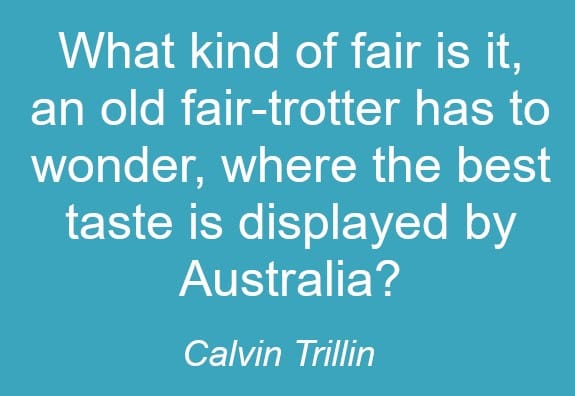
The highlight of the Australia Pavilion, all agreed, was the Australians. The pavilion staff were celebrated as being warm, charitable, hospitable, cheerful, and "very, very sociable." John Allen, the official driver for the Australian pavilion staff at Expo '74, described them as "mini-celebrities."(5)
SOUVENIR OF THE WEEK
I actually don't have any souvenirs from the Australia Pavilion, only brochures and booklets. So this week, I'll feature this black velvet pillow that is decorated with gold tassels and neon painted versions of some of the Caplan art I talked about last week. It is so hideous. I treasure it deeply.
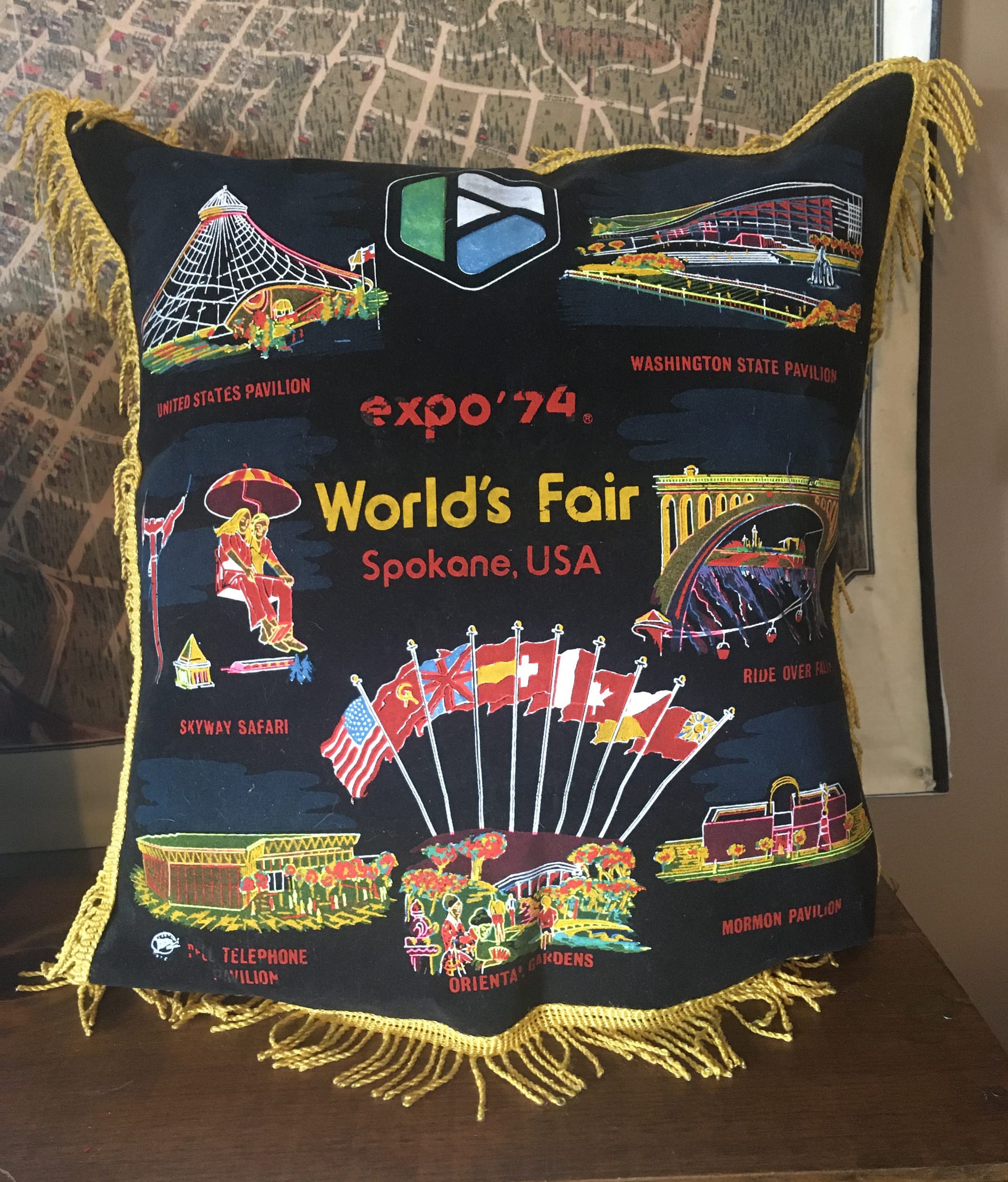
Until next time!
References and Footnotes
- "'Baltic Week' Set At Folklife Festival." (June 4, 1974). Spokesman-Review, p. 26. Via Newspapers.com: https://www.newspapers.com/article/the-spokesman-review-baltic-week-set-a/148497078/
- Sources are not very consistent about whether Native Americans' Earth was under the general Folklife umbrella or whether it was a similar exhibit sharing the same patch of the fairgrounds as Folklife.
- "This Week At Expo '74." (June 3, 1974). Spokane Chronicle, p. 31. Via Newspapers.com: https://www.newspapers.com/article/spokane-chronicle-this-week-at-expo-74/148541438/
- "Expo Today: Fair's Timetable." (June 1, 1974). Spokesman-Review, p. 3. Via Newspapers.com: https://www.newspapers.com/article/the-spokesman-review-expo-today-fairs/148494046/
- Youngs, J. W. T. (1996). The Fair and the Falls: Spokane's Expo '74. Eastern Washington University Press.
- "Flags Taken." (June 5, 1974). Spokane Chronicle, p. 11. Via Newspapers.com: https://www.newspapers.com/article/spokane-chronicle-flags-taken/148497457/
- Roberts, Jack. (June 5, 1974). "Council Acts To Curb Daredevils On River." Spokesman-Review, p. 16. Via Newspapers.com: https://www.newspapers.com/article/the-spokesman-review-council-acts-to-cur/148497585/
- "False Surveys." (June 4, 1974). Spokesman-Review, p. 1. Via Newspapers.com: https://www.newspapers.com/article/the-spokesman-review-false-surveys/148496802/
- "Public Walks To Point Up Plight Of World's Whales." (June 4, 1974). Spokane Chronicle, p. 3. Via Newspapers.com: https://www.newspapers.com/article/spokane-chronicle-public-walks-to-point/148583141/
- "Sierra Club Criticizes Ouster From Expo '74." (June 6, 1974). Spokesman-Review, p. 7. Via Newspapers.com: https://www.newspapers.com/article/the-spokesman-review-sierra-club-critici/148497709/
- "Whale Supporters March Around Expo." (June 6, 1974). Spokesman-Review, p. 3. Via Newspapers.com: https://www.newspapers.com/article/the-spokesman-review-whale-supporters-ma/148497725/
- "Russians, Japanese Deny Allegations of Hypocrisy." (June 5, 1974). Spokesman-Review, p. 6. Via Newspapers.com: https://www.newspapers.com/article/the-spokesman-review-russians-japanese/148583119/
- "Philadelphia Orchestra Performs Tonight." (June 6, 1974). Spokesman-Review, p. 1. Via Newspapers.com: https://www.newspapers.com/article/the-spokesman-review-philadelphia-orches/148497783/
- "Champagne Music." (June 6, 1974). Spokesman-Review, p. 1. Via Newspapers.com: https://www.newspapers.com/article/the-spokesman-review-champagne-music/148497810/
- "Music Dominates Expo's Program." (June 6, 1974). Spokane Chronicle, p. 1. Via Newspapers.com: https://www.newspapers.com/article/spokane-chronicle-music-dominates-expos/148497880/
- Dechsel, Laura. (June 9, 1974). "Fair Greets Millionth Guest, Honors Two Governors." Spokesman-Review, p. 6. Via Newspapers.com: https://www.newspapers.com/article/the-spokesman-review-fair-greets-million/148499004/
Powers, Dorothy R. (January 22, 1974). "Building Contract Signed." Spokesman-Review, p. 4. Via Newspapers.com: https://www.newspapers.com/article/the-spokesman-review-building-contract-s/141910456/
"Trilogy Of Life Portrayed In Australia's 3 Exhibits." (May 5, 1974). Spokesman-Review, p. b23. Via Newspapers.com: https://www.newspapers.com/article/the-spokesman-review-trilogy-of-life-por/141910325/

